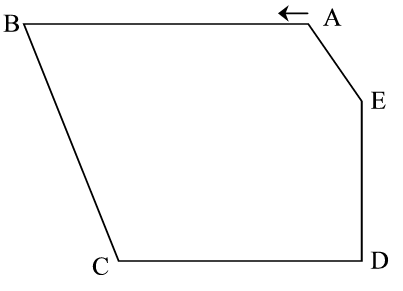| << Chapter < Page | Chapter >> Page > |
1. 88
2. 8,8
3. 0,88
4. 11
5. 110
6. 1,1
7. 0,11
8. 0,111
9. 1 000 m
10. 10 mm
11. 1 000 m
12. 1 000 000 mm
13. 208
14. 8
15. 39
In this module we are going to measure with the aid of various instruments.
We are going to measure:
1. An ant must walk from A to B, then to C, D, E and again to A (right around – perimeter).

1.1 What instrument will you use to calculate how far the ant walks?
1.2 Now calculate the distance the ant has walked.
_____________________________________________________________________
_____________________________________________________________________
1.3 In what unit did you measure? _____________________________________
1.4 What unit did your friend use? _____________________________________
2. Take a look at the following figures. Are you able to tell the educator what the "ordinary" name for each one (excepting the square) is?

square
2.1 These shapes are regular. Why?
_____________________________________________________________________
_____________________________________________________________________
_____________________________________________________________________
_____________________________________________________________________
2.2 Calculate the perimeter of each shape (remember the units). Write the name of each shape, followed by the answer.
(a) __________________________________________________________________
(b) _________________________________________________________________
(c) __________________________________________________________________
(d) _________________________________________________________________
2.3 If the perimeter of a square can be calculated by means of the formula 4 x side, which formula would be used for each of these shapes? Write the name of the shape, followed by the answer.
(a) __________________________________________________________________
(b) _________________________________________________________________
(c) __________________________________________________________________
(d) _________________________________________________________________
2.4 What do we call the following shape?

_____________________________________________________________________
2.5 Can you perhaps deduce a formula for calculating the perimeter of a rectangle?
_____________________________________________________________________
REMEMBER THIS!
A square also happens to be a rectangle. It just happens to be one with four equal sides. All squares are rectangles, but all rectangles are not square.
3. Here are a few irregular shapes.

3.1 Why do we say that these shapes are irregular?
_____________________________________________________________________
3.2 Now calculate the perimeter of each of the irregular shapes.
A: __________________________________________________________________
B: __________________________________________________________________
C: __________________________________________________________________
Learning Outcome 4: The learner will be able to use appropriate measuring units, instruments and formulae in a variety of contexts.
Assessment Standard 4.4: We know this when the learner estimates, measures, records, compares and orders two-dimensional shapes and three-dimensional objects using S.I. units with appropriate precision for:
4.4.3: length using millimetres (mm), centimetres (cm), metres (m) and kilometres (km);
Assessment Standard 4.8: We know this when the learner investigates and approximates (alone and/or as a member of a group or team):
4.8.1: perimeter using rulers or measuring tapes.

Notification Switch
Would you like to follow the 'Mathematics grade 6' conversation and receive update notifications?